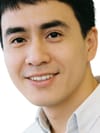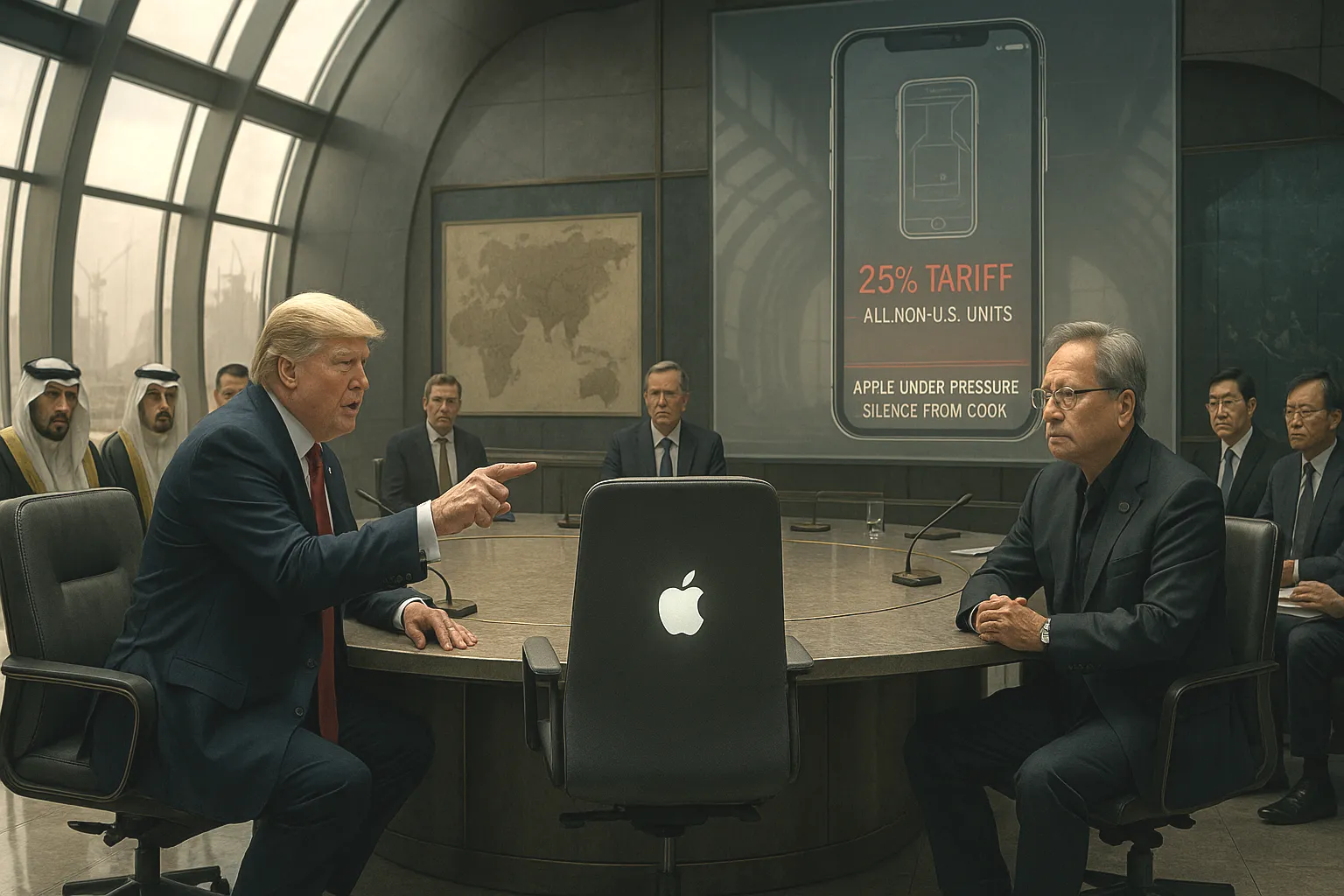💡 TL;DR - The 30 Seconds Version
🎯 Trump threatened a 25% tariff on all iPhones made outside the US after Apple CEO Tim Cook skipped his Middle East trip.
✈️ Cook declined to join Trump's Saudi Arabia, UAE, and Qatar tour while other tech CEOs like Nvidia's Jensen Huang attended.
📊 Apple had just won exemption from a 145% China tariff in April through Cook's lobbying efforts.
🏭 The threat came after reports that Apple's supplier Foxconn will spend $1.5 billion on an iPhone plant in India.
🌍 Cook went from being Trump's "most beloved" CEO to his biggest corporate target, ending his role as tech's Trump whisperer.
🚀 Trump wants all iPhones sold in America built in America, setting up a high-stakes showdown with Apple's global manufacturing strategy.
Tim Cook made a calculation. When Trump invited tech CEOs to join his Middle East victory lap, Cook said no. Other executives packed their bags for Saudi Arabia, the UAE, and Qatar. Cook stayed home.
That decision now looks expensive. Very expensive.
Days after Cook's no-show, Trump threatened a 25% tariff on every iPhone made outside America. The timing wasn't subtle. Neither was Trump's message during the trip itself. While praising Nvidia's Jensen Huang in Riyadh, Trump made sure everyone heard his pointed aside: "Tim Cook isn't here, but you are."
The relationship between America's most powerful tech CEO and its most unpredictable president has officially broken down. Cook spent years building influence through face-time and strategic compromises. Now he's watching that approach crumble in real time.
Trump's tariff threat caught his own administration off guard. Apple executives were equally blindsided. Just over a month earlier, Cook had successfully lobbied to exempt iPhones from a crushing 145% China tariff. That win now looks like ancient history.
The breakdown represents a stunning reversal for Cook. During Trump's first term, he earned a reputation as tech's most effective Washington operator. He showed up when it mattered. He made the right investments. He avoided unnecessary fights. Trump rewarded him with access and relative peace.
The president even gave him a nickname. "Tim Apple" became shorthand for their unusually cozy relationship. Trump bragged that Cook called him regularly while other CEOs ignored him.
Those days are over.
Cook's absence from the Middle East trip violated an unspoken rule of Trump diplomacy: show respect through presence. Other tech leaders understood the assignment. Huang flew halfway around the world to hear Trump's speeches. Sam Altman from OpenAI made the journey. So did AMD's Lisa Su and dozens of other executives.
In Qatar, Trump made his irritation explicit. He told business leaders he had "a little problem with Tim Cook" and complained about Apple's growing manufacturing footprint in India. The president's logic was straightforward: if Apple wanted to sell phones in America, it should make them here.
Hours later, the tariff threat appeared on Truth Social. Trump's post was direct and personal. He had "long ago informed Tim Cook" that iPhones sold in America should be built in America. The alternative was a 25% penalty.
The timing aligned perfectly with news that Foxconn, Apple's key supplier, planned to spend $1.5 billion on an iPhone plant in India. Trump saw this as defiance, not business strategy.
Cook's diplomatic approach once shielded Apple from political attacks. Now it makes the company a bigger target. Trump expects more from CEOs he considers allies. When they disappoint him, the retaliation comes swift and personal.
Apple has tried to appease Trump with promises of American investment. The company pledged $500 billion in U.S. spending over four years. Cook highlights plans to source 19 billion chips from American facilities, including new TSMC plants in Arizona. Apple will build AI servers in Houston.
None of this satisfies Trump. He wants the crown jewel: iPhone production itself. Semiconductors and servers don't generate the same political symbolism as assembly lines churning out America's favorite gadget.
Trump's demand puts Apple in an impossible position. Moving iPhone production to America would require massive investment with uncertain returns. Labor costs would rise significantly. Supply chains would need complete restructuring. The complexity alone would take years to resolve.
Apple has chosen a different path. The company has steadily moved iPhone assembly to India while keeping China as its primary manufacturing base. This strategy reduces dependence on any single country while accessing lower-cost labor markets.
Trump sees this as betrayal, not pragmatism.
The conflict comes at a particularly bad time for Cook. Apple faces multiple challenges that would normally demand his full attention. A federal judge recently ruled against Apple in an App Store case, saying executives had "outright lied under oath." The company's Vision Pro headset disappointed buyers and investors. A promised Siri upgrade got delayed, raising questions about Apple's AI strategy.
Most painfully, Jony Ive joined OpenAI last week. Apple's former design chief, who helped create the iPhone, now works for a company building potential Apple competitors. The symbolism stings.
Despite these setbacks, Apple's financial performance remains strong. The company generates nearly $100 billion in annual profit. Its market value has grown by $2.5 trillion under Cook's leadership.
But politics doesn't follow financial logic. Trump's tariff threat shows how quickly business relationships can turn personal. The president wants visible commitments, not spreadsheet promises.
Cook now faces a choice that defines his legacy. He can fight Trump publicly and risk escalating retaliation. He can compromise privately and hope for a face-saving deal. Or he can stay silent and let the situation fester.
His response will determine whether Apple's most successful CEO can adapt to a new era of corporate-political warfare. The stakes go beyond Apple's bottom line. They touch the fundamental question of how American companies navigate an increasingly politicized business environment.
Trump made his position clear on Friday: "If they're going to sell it in America, I want it to be built in the United States. They're able to do that."
Cook hasn't responded publicly. His silence speaks volumes.
Why this matters:
- Cook's fall from Trump's inner circle shows how quickly corporate-political relationships can collapse when CEOs prioritize business over personal diplomacy
- This standoff will test whether Apple's global manufacturing strategy can survive direct presidential pressure, setting precedent for how other multinational companies handle similar threats
❓ Frequently Asked Questions
Q: How much would a 25% tariff actually cost iPhone buyers?
A: A 25% tariff on an $800 iPhone would add $200 to the retail price, assuming Apple passes the full cost to consumers. Apple could absorb part of the tariff to keep prices competitive, reducing profit margins instead.
Q: Which other tech CEOs joined Trump's Middle East trip?
A: Jensen Huang (Nvidia), Sam Altman (OpenAI), Larry Fink (BlackRock), Jane Fraser (Citigroup), and Lisa Su (AMD) attended. The trip included stops in Saudi Arabia, UAE, and Qatar over several days in May 2025.
Q: How much does Apple currently manufacture in the United States?
A: Apple will source 19 billion chips from U.S. facilities this year, including from TSMC's Arizona plants. The company plans AI server production in Houston but assembles virtually no iPhones domestically. Most production remains in China and India.
Q: What was the 145% China tariff that Apple avoided?
A: In April 2025, Cook successfully lobbied for an exemption from a massive 145% tariff on Chinese-assembled iPhones. This victory came just weeks before Trump's new 25% threat on all foreign-made iPhones, regardless of country.
Q: When would Trump's threatened iPhone tariffs actually take effect?
A: Trump said the tariffs would begin at the end of June 2025 and would affect all smartphones made abroad, including Samsung devices. However, presidential tariff threats don't always become policy, and implementation timelines often change.








